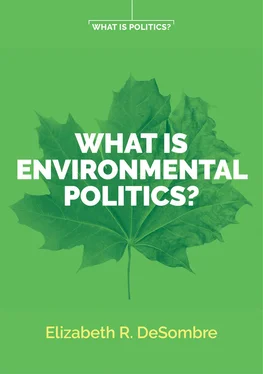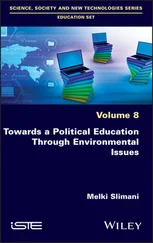Subtractability is a characteristic of common pool resources that other types of public goods problems (such as the operation of lighthouses to warn ships of hazards or the creation of public broadcasting systems) don’t have, and that can therefore make them harder to address cooperatively. This logic, again, supports the need for political solutions to environmental problems. Mandating or prohibiting action by all relevant contributors to a problem can be important, since free-riders can undermine any collective solution. But it can be difficult to find political solutions when they would be costly for some of those who would be regulated.
The potential disconnect between when and where an environmental problem is caused and when and where its effects are felt is another element of environmental issues with important implications for environmental politics. Some environmental problems are felt immediately after they are created, in close proximity to the activities that create them. Indoor air pollution from poorly ventilated stoves, one of the major sources of this type of pollution in poor countries, has these characteristics.
But many environmental issues are experienced distant in either time or space from where the activities that create them take place. Invasive species may become a threat only decades or more after a first non-native species arrives in an ecosystem. Chlorofluorocarbons (CFCs) can cause problems for the stratospheric ozone layer a century or more after they were initially emitted. Some substances, such as greenhouse gases or acid rain, may take time to accumulate in sufficient quantities before major effects are felt.
The same kind of disconnect happens with distance. Much of the plastic that ends up in the garbage patches in the middle of the ocean was used on land, often far from the coasts. Acid rain can occur hundreds of miles from the power plant emissions that cause it. Persistent organic pollutants, such as polychlorinated biphenyls (PCBs) and dioxins, have been found in the blood and breast milk of indigenous peoples in the Arctic far from where these substances were used.
These lags in time and distance matter for several reasons. They can add to uncertainty (discussed in chapter 2) since, if a problem emerges far in time or space from its causes, the connection between cause and effect may not be immediately made. It also means that, by the time a problem is noticed, the behavior that causes it may already be widespread and thus harder to change. And on the side of resolving problems – which is often the stage at which the political process becomes involved – the time between when a behavior stops and a problem is resolved may be quite long, requiring people to take costly action long before the benefit is felt, which politicians may be reluctant to demand. The distance between cause and effect can be politically problematic if the causes of an environmental problem – and thus the location where the costs of changed behavior are felt – is in a different jurisdiction than the location where the effects – and thus the benefits of change – are experienced.
Non-linearities/Tipping Points
Another important element of some environmental problems is that their effects may be related in a non-linear way to their causes. We tend to think of problems as having a clear and consistent relationship between cause and effect: the more CFCs we emit, the more the ozone layer is depleted, and when we stop the emissions the ozone layer will recover. But for many environmental problems the relationship is more complex. There may be tipping points after which changes in natural systems mean that recovery to a previous state is no longer possible. A species may suddenly collapse once a sufficient percentage has been harvested. Enough climate change may cause ocean currents to slow or change direction, dramatically altering weather patterns around the world. More dramatic are feedback loops in which effects compound. For example, as the global average temperature increases, ice melts. Because ice reflects sunlight, when it melts the system takes in more sunlight and warms even more, which causes more ice to melt, and so on. Once this kind of feedback loop engages, it continues to magnify. One of the particular dangers of climate change is that it features many such feedback loops. In other words, more climate change leads to even more (and even faster) climate change. These characteristics of some environmental problems make it more difficult to understand the relationship between cause and effect and increase the urgency of intervening before such dangerous tipping points or feedbacks happen.
Effects of Scarcity: Will We Run out of Resources? Another important aspect of environmental issues is their intersection with economics: in particular, how people and systems respond to scarcity. Because non-renewable materials are finite, people often express concern that we will use up these resources. Given their importance to our industrial economy, no longer having access to these resources could be problematic. The economist Julian Simon argued that we will never run out of non-renewable resources, 3and it’s worth understanding his reasoning.
Simon made a bet with Paul Ehrlich, a biologist concerned that the world’s growing population would lead us to run out of resources, especially those that are not renewable. Ehrlich’s logic is easy to understand: as more people use more of these resources, either because there are more people or because the same number of people use more, there will be fewer of them left.
The famous Simon–Ehrlich wager took place in 1980. 4Ehrlich chose $1,000 worth of five metals – copper, chromium, nickel, tin, and tungsten. He bet that ten years later the inflation-adjusted value of these metals would be higher, which is what you would expect if they were becoming scarcer relative to demand. It is a basic tenet of economics, accepted by both Simon and Ehrlich, that when demand increases relative to supply (in other words, when there is the same amount of something but more people want it, or when the same number of people want something but there is less of it) prices will increase. Simon, who was not concerned that we would run out of resources, bet that the collective price would decrease.
Simon won the wager; collectively the prices in 1990 had decreased. It’s worth noting that there were periods of time during that decade in which the prices actually had increased; if the bet had been called at that point, Ehrlich would have won. But the broader trend was on Simon’s side, and it’s useful to explore both the mechanisms for that and their implications for the possibility of using up non-renewable resources.
It is because these resources become more expensive as they become scarcer (or as demand increases relative to supply) that several other important processes are set in motion. We are more likely to conserve, to substitute, and to innovate because of the increasing cost. For purposes of illustration, let’s examine what happens with oil, which includes things such as the gasoline used in most motor vehicles.
When oil becomes scarcer, gasoline prices rise. When fuel costs more, we are likely to use less of it, both as individuals and as a society. Some people might start to carpool to get to work, so that more people are commuting with the same amount of gasoline. Others might wait between trips to the supermarket, so that they use less gasoline per trip. Industry users will try to figure out whether they can become more efficient in their use of fuel, because it costs more. Can they heat or cool buildings less? Run machinery less often? Capture waste heat from mechanical processes to help heat buildings? All of these approaches can fit under the idea of conservation.
Читать дальше












